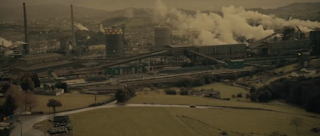Infiesto is a dark Spanish thriller film that has become rather popular in Netflix. I've recently watched it and I've pretty enjoyed it. The plot is good, not particularly memorable, but entertaining, with good ideas (nothing new, but a good mix) that should have been further developed with an extended duration, or better, in a series.
The film is named after an Asturian village, L'Infiestu/Infiesto and is filmed in Asturies (mainly) and Galiza (the church in ruins with its Cruceiro, and the Hospital San Rafael in A Coruña). So yes, it's obvious that I was pretty interested on this film since I knew about it. The opening scene is an aerial view of Mieres, followed by a girl crossing the bridge that joins the railway station to the town.
We see some magnificent industrial ruins, massive, alive and well, industrial facilities (Arcelor Tabaza), run down farms, and of course, an abandoned coal mine, a testament to a nearby time of wealth and progress (yes, many Asturians still see coal as the source of life that it represented for our land, and not as the evil global warming monster...). There's a gloomy, oppressive, decadent atmosphere, rain, mud and humidity everywhere (that reminds me again that this Autumn and Winter are not behaving as they should). Asturies is a perfect setting to create this dark aesthetic, it's not chauvinism, it's reallity.
To my surprise (before watching the film I thought it had been entirely filmed in the "Cuenca Minera", the former coal mining areas), my hometown, Xixón, is well present in the film. The Police headquarters are set 10 minutes walking from my flat! There are road views of Avenida Constitución and the film ends with an aerial view of the southern neighbourhoods (Pumarín, Nuevu Xixón).
Unfortunately the film is too short, it ends too fast, and as I aforementioned I think the idea and scenario would have been great for a much longer development as a series. We could hope that this film could inspire other directors to leverage the Asturian landscapes and ruins for future works. The internationally recognized Asturian director Sergio G Sánchez made an excellent use of the Asturian landscape in his last work The Girl in the Mirror. It's like a teenage dark fantasy thriller, that is not exactly my favorite kind of story (I think it's mainly the teenage thing what does not please me), but the presence of the Asturian landscape is sublime (the opening scene with the bus going down that winding mountains road, the cave, the coast, the coastal village (L.luarca)... Something that I have to admit that I found a bit bothering in "The girl in the mirror" (and that has become so common) is the overrepresentation of homosexuality. We've moved from a time when films kept the LG community invisible, trying to sweep under the carpet something that felt uncomfortable (or plainly wrong) to the society of that time, to the current time where every film or series has to have at least one gay and one lesbian couple (or at least bisexual). I think this is way more than the proportion of homosexuals in the real world, so it's a way of deforming reality. I'm really fine with faking reality to promote positive, healthy, superior values (so for example I would pretty agree with showing a bigger proportion of vegans/vegetarians in films than the real one), but as I don't think homosexuality is better (or worse) than heterosexuality, I don't see any reason to promote it (or to discourage it).






No comments:
Post a Comment